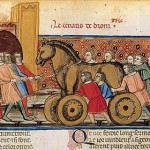 “Car quant on voit painte une estoire, ou de Troies ou d’autre, on voit
“Car quant on voit painte une estoire, ou de Troies ou d’autre, on voit
les faites des preudhommes ki cha en ariere furent, ausi com s’il fussent present.
Et tout ensi est il de parole. Car quant on ot .i. romans lire, on
entent les aventures, ausi com on les veïst en present.”
(Richart de Fournival, Li bestiaires d’amours)
“Ne sont que .iij. matieres à nul home antandant:
De France et de Bretaigne et de Rome la grant.
Et de ces .iij. matieres n’i a nule semblant.
Li conte de Bretaigne sont si vain et plaisant;
Cil de Rome sont sage et de san aprenant;
Cil de France de voir chascun jor apparant.”
(Jean Bodel, Chanson des Saxons)
The growth of profane narrative literature represented a profound challenge for painters and particularly for illuminators: faced with the limits of applicable material from the traditions of European painting – which had emerged from the spectrum of religious subjects – they created new pictorial systems. This required invention, imagination, and creative engagement with the texts in a way that had not occurred for centuries. But the users of the books were also challenged: their imaginations were supported by the painted images, and, at the same time, determined by them – a tension that surely influenced the reading and memory of texts. The illustration of epics probably made an essential contribution to the development of reading, book, and visual culture in the Late Middle Ages.
The conference seeks to examine particularly manuscripts with extensive pictorial cycles.
Possible subject areas :
• Questions of layout – one-off and serial production – impact on pictorial invention
• Between Antiquity and divine history
• Epics as entertainment literature and women’s literature
• Poetic images – painted images – world images
• Affects in text and image
Papers should be no longer than thirty minutes. Travel and accommodation costs for speakers will be covered by the organisers.
Subject proposals should be sent together with a short abstract before 9 September 2012 to :
Dr. Costanza Cipollaro & Dr. Maria Theisen
Institut für Kunstgeschichte der Universität Wien
Universitätscampus AAKH Hof 9
A 1090 Wien / Österreich
eMail: costanza.cipollaro@univie.ac.at et maria.theisen@univie.ac.at
Epen-Illustrationen des 13. bis 15. Jahrhunderts
Organisateurs du colloque international :
Universität Wien, Institut für Kunstgeschichte, Pächt-Archiv / Forschungszentrum für Buchmalerei.

Leave a Reply
You must be logged in to post a comment.